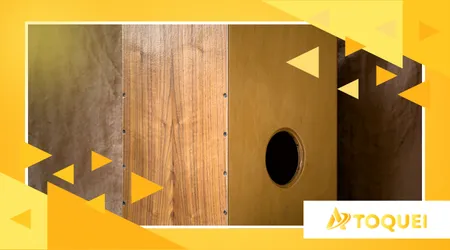Review: Brazilian Cajón vs. Spanish Cajón

The world of percussion has at its center a versatile and captivating instrument: the cajón. The choice between Brazilian Cajón vs Spanish Cajón is one of the biggest doubts of percussionists.
Advertisements
After all, subtle differences arise from distinct cultures and musical needs. Let's dive into this detailed analysis to help you make your decision.
Origins and Evolution: Roots that Shape Sound
The cajón, in its essence, has Afro-Peruvian roots, but it was in Spain which gained its modern form and was popularized in flamenco.
This version is the matrix of what we know. Its construction is designed to highlight the dry bass and the snare acute.
However, the Brazil, a master of adapting rhythms and instruments, developed his own version. This variation arose from the search for a more comfortable instrument with sound projection.
Advertisements
It's not just a copy, but a recreation with a strong identity.
Read more: Is it worth buying a pedal board or separate pedals?
Design and Ergonomics: The Question of Position
The most notable feature of the Spanish cajón is that the musician sits on the instrument. This requires an upright posture and offers a direct attack angle. The classic Spanish is usually more compact and straight.
On the other hand, the Brazilian Cajon innovated by adopting the “chair” format or inclined. The percussionist sits more reclined and comfortable, which facilitates long sessions.
This design also influences how the sound is projected.

The Sound Essence: The Heart of Difference
Acoustic properties are at the heart of the discussion about Brazilian Cajón vs Spanish Cajón. Each one has an ideal timbre for its musical purpose.
The Spanish (or Peruvian/flamenco) cajón prioritizes clear separation between the bass (dry and powerful bass) and the treble (the “box” sound or snare).
THE snare is usually made with guitar strings or internal basses. The sound is crisp and precise, essential for flamenco counter-tempos.
++ Compilations, reissues or remasters: what's the difference and why do they matter in music?
The Brazilian model seeks a more full and resonant. Many models use drum tracks (snare wire) instead of strings.
This results in a more "open" high note with greater sustain. The bass response tends to be deeper, with more body.
Building Material and Innovation
Historically, the cajón was made from simple wood from shipping crates. Today, quality is a differentiator. Brazilian and Spanish brands are investing in woods such as Birch (Birch) and MDF.
The use of hardwoods in Brazil, such as naval plywood, is common to ensure durability. The faceplate, or slap, is crucial. In Brazil, thinner slaps are used for greater sensitivity.
++ Top 5 Headphones for Musicians Practicing at Home
Musical Versatility: Rhythm and Adaptation
The Spanish cajón shines in the flamenco and in acoustic rhythms that require rhythmic precision. Its dry and punchy makes it ideal for unplugged and world music.
The Brazilian cajón, due to its more full-bodied and to the snare more open, it adapted perfectly to the samba, pop, country and MPB.
It can convincingly replace a drum in small spaces. The sound of the Brazilian Cajón vs Spanish Cajón determines where it best fits.
Think about it: if the Spanish cajón is a espresso (intense, concentrated and direct), the Brazilian is a filtered coffee (softer, with more volume and body). This analogy helps to understand the difference in sound.
The Weight of Statistics and Market Opinion
A relevant market fact demonstrates this versatility.
Market research on musical instruments in Brazil indicates that, since 2018, sales of cajóns in the country have surpassed the combined sales of acoustic and electronic drum sets in stores focused on beginners.
This dizzying growth is attributed to the portability and low cost of the national instrument, leveraging the Brazilian Cajón vs Spanish Cajón in the domestic scenario.
The accessibility of the national model is undeniable.
Technical Comparison: A Structural View
The table below summarizes the main structural differences between the models.
| Feature | Spanish Cajon (Flamenco) | Brazilian Cajon (Inclined) |
| Ergonomics | Sitting on (straight) | Sitting reclining (leaning) |
| Snare Feature | Guitar Strings / Bass Strings | Snare Wire |
| Grave Timbre | Dry, Punchy and Concentrated | Full, Deep and Resonant |
| Cover (Front Plate) | Generally thicker | Generally thinner/more sensitive |
Sound in Action
To illustrate the application, consider two scenarios. A percussionist Flamenco in southern Spain a straight model is used.
He needs that one crack sharp and fast, like a snap, to accompany the tap dancing and guitar. The bass is used as punctuation.
Already at a show Acoustic MPB On Paulista Avenue, the percussionist uses the inclined model. He is playing a baião rhythm.
In this context, it needs a bass that fills the room and a treble with more sustain, which imitates the backbeat from the box.
The Brazilian model fits better. It's a difference in musical purpose, not quality.
Conclusion: The Choice is Yours, Musician
We get to the heart of the matter: Which is best? The best cajón is the one that meets your musical and ergonomic needs.
If you are looking for the flamenco tradition, go for Spanish. If you're looking for Brazilian pop versatility and prolonged comfort, the national model is the choice.
Brazilian Cajón vs Spanish Cajón: the duel is purely stylistic.
After all, if both are made to make music and adapt to different cultures, wouldn't the true victory be creative fusion that they inspire?
Consider what your music needs and choose wisely. Your percussive journey awaits!
Frequently Asked Questions
Can the Brazilian cajón be used to play flamenco?
Yes, definitely. Although the traditional flamenco timbre is drier, many percussionists use the Brazilian cajón, especially if it's modified with strings, not a ratchet. The key is the musician's technique.
Which model is generally more expensive?
Prices vary greatly depending on the brand and material.
In Brazil, the national model tends to be more affordable, given local production, but there are premium models of both types that reach high prices on the market.
Does the inclination of the Brazilian cajón really make a difference in comfort?
The tilt is the main ergonomic difference. It allows the musician to keep their spine straighter and more relaxed. For long shows or those with posture issues, this difference is noticeable.
Where can I buy a quality cajón?
It is always recommended to look for reliable musical instrument stores or specialized luthiers.
Look for renowned brands, both national (such as FSA, RMV) and international (such as Schlagwerk, De Gregorio), to ensure sound quality.
